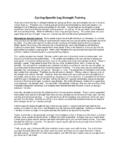Transcription of Basics of Cycling Physiology and Training
1 0 Ba Basics of Cycling Training n David Ertl USA Cycling Level 1 Coach i Disclaimer This e- book is intended to inform the reader of the Basics of a Cycling fitness program. Training methods outlined herein should not be adopted without consultation with your health professional. Use of this information herein is at the sole choice and risk of the reader. The author is neither responsible for, nor liable for any harm or injury resulting from, the use of the information described herein. About the Author Coach David Ertl has been riding and racing bikes practically all his life. He began riding at age 5, began competing in 1973, and he continues to compete as a Master s athlete to this day. David became a certified coach with USA Cycling in 2002.
2 In 2004 he became a Certified Personal Trainer with the National Strength and Conditioning Association (NSCA) and in 2007 obtained the highest coaching level offered by USA Cycling , Level 1. David coaches individual cyclists as well as two teams, the Des Moines Cycle Club Race Team and the Iowa Chapter of the JDRF Ride to Cure Diabetes Team. In addition to personal coaching, David also provides online Training plans and information, including 15 week and annual Training plans for recreational and competitive cyclists and triathletes. Learn more about his background and coaching programs at . He has written three book : 101 Cycling Workouts , Training For Busy Cyclists , and Indoor Training for Cyclists , which are available online at He and his wife, Angie, own the 24/7 X-Press Fitness Center and Pilates Studio in Des Moines, Iowa.
3 He and his family ride and reside in Waukee, Iowa. He can be reached at . ii Forward This e-booklet is a short but concise summary of the basic ideas behind the creation of a structured, periodized Cycling Training plan. It discusses the capabilities and physiological systems required by road cyclists to perform in all aspects of the sport, and gives a sampling of workouts and what they are intended to improve. There s a lot more to it than just riding your bike . This e- book will help you understand the theory behind a structured Training plan, to either help you design one on your own, or if you work with a coach to help you better understand what the coach is trying to accomplish and how.
4 If you are interested in learning more about how to train efficiently and effectively, check out the pre-built Training plans, eBooks, and other resources available at . Please feel free to pass this eBook along to your Cycling friends. Don t just ride your bike, Train! -- David Ertl 1 Basics of Cycling Training Bicycle racing demands a wide range of physiological capabilities, from being able to ride at race pace for hours and then finish with a sprint at full speed, to be able to climb long and short hills, to accelerating anaerobically several times per mile in a criterium. Unlike Cycling , many endurance sports do not require the extremes in physiological capabilities ( marathoners don t need a fast sprint). Because Cycling requires such a wide range of capabilities, it is a challenge to develop a Training plan that prepares a cyclist for all aspects adequately.
5 Cyclists ultimately need well developed Cycling Proficiencies. These are supported by Physiological Capabilities, which in turn are supported by Physiological Systems. To improve these physiological systems requires developing Training Adaptations which in turn determine the type of Training Sessions required. Cycling Proficiencies | Physiological Capabilities | Physiological Systems | Training Adaptations | Training Sessions A. Cycling Proficiencies Let s start by looking at the required Cycling proficiencies required by an all-around road cyclist. Those discussed here include only the physiological proficiencies, not skills, tactics, or mental proficiencies, which are also required for success.
6 The main ones include: - Sprinting - Climbing (long mountains and short hills) - Time trialing - Attacking/chasing breaks/accelerations - Multi-hour road racing 2 B. Physiological Capabilities To support these Cycling proficiencies, there are several physiological capabilities that are called upon to provide the required output. These can be categorized in three general ways. Every form of Cycling is some combination of strength, endurance, and level of intensity. Intensity level is described and measured in several ways (% of maximum heart rate; % of V02 max; heart rate zones 1-5; % of Lactate Threshold; watts; relative perceived exertion (RPE) values 1-20). Cycling = STRENGTH x ENDURANCE x INTENSITY The combination of these three capabilities is different for each of the Cycling proficiencies.
7 Time trialing is a rather equal combination of strength, endurance, and level of intensity. Sprinting requires maximum intensity and strength but no endurance. Chasing down a break requires a fairly high intensity level (anaerobic) with limited endurance. The following diagram shows how these Cycling proficiencies fit into the three major physiological capabilities. Each of these types of Cycling types requires a different combination of the three physiologies. Note that there is not a type of Cycling that requires high strength at an aerobic pace (upper left), just as there are no types that require high endurance and anaerobic conditions (lower right). These pairs of capabilities don t go together. Understanding this chart will allow you to think about the three sets of physiological capabilities you need to develop. 3 Low Intensity (Aerobic) Road Races Long Hills Long Time Trials Strength ( ) Endurance Med Hills Short Time Trials Criteriums Attacks and Breaks Short Hills Sprinting High Intensity (Anaerobic) 4 C.
8 Physiological Systems Behind the physiological capabilities are physiological systems that explain the basis for being able to perform Cycling activities as well as explain how exercise improves the physiological capabilities. To perform in Cycling , the body has three major physiological systems to support the exercise. These are the Cardiovascular, Energy and Muscular systems. Types of physiological systems: I. Energy Systems II. Cardiovascular System III. Muscular System I. Types of Energy Systems: - Creatine-Phosphate (10-15 second efforts) - Anaerobic (30 seconds to two minutes) - Aerobic (long efforts 4 min to hours) II. Cardiovascular System: Maximum Heart Rate (MHR) is the highest rate your heart is capable of beating under the maximum exertion. Lactate Threshold (LT) or Anaerobic Threshold (AT) is the heart rate at which you begin to accumulate lactic acid in your muscles where anaerobic energy production surpasses aerobic.
9 It is the rate at which the effort is no longer sustainable for long periods of time. This generally occurs at 85-92% of MHR. Various Cycling coaches use different zones. I use six and they are listed below, and are based on percentage of your anaerobic or lactate threshold. Heart Rate Zones: Zone 1 = Recovery (<71% of AT) uses the aerobic system Zone 2 = Endurance (72-81% of AT) uses the aerobic system Zone 3 = Tempo Pace (82-91% of AT) uses mainly aerobic system Zone 4 = Threshold Pace ( 92-102% of AT) uses mainly aerobic system with some anaerobic system Zone 5 = Anaerobic Pace (103-110% of AT) covers zone where aerobic converts to the anaerobic system. Zone 6 = Maximum aerobic capacity (Too short to record HR) anaerobic and CP systems 5 Your cardiovascular output can also be measured with power if you use a power meter on your bike.
10 Similar to heart rate, there are also power zones. My six zones are shown here for power, and are based on those of Hunter Allen and Andrew Coggan. Power Zones: Zone 1 = Recovery (<55% of TP) uses the aerobic system Zone 2 = Endurance (56-75% of TP) uses the aerobic system Zone 3 = Tempo Pace (76-90% of TP) uses mainly aerobic system Zone 4 = Threshold Pace ( 91-105% of TP) uses mainly aerobic system with some anaerobic system Zone 5 = Anaerobic Pace(106-120% of TP) covers zone where aerobic converts to the anaerobic system. Zone 6 = Maximum capacity (V02 Max) (>120% of TP) anaerobic and CP systems How to estimate your AT or TP: AT and TP is the maximum sustainable pace you can maintain during a time trial effort that lasts about an hour. However, it s possible to estimate this heart rate or power from a shorter 20 min time trial effort.





